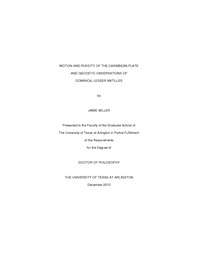
ATTENTION: The works hosted here are being migrated to a new repository that will consolidate resources, improve discoverability, and better show UTA's research impact on the global community. We will update authors as the migration progresses. Please see MavMatrix for more information.
Show simple item record
| dc.contributor.author | Miller, Jamie Annette | |
| dc.date.accessioned | 2017-05-31T19:20:49Z | |
| dc.date.available | 2017-05-31T19:20:49Z | |
| dc.date.submitted | January 2013 | |
| dc.identifier.other | DISS-12484 | |
| dc.identifier.uri | http://hdl.handle.net/10106/26660 | |
| dc.description.abstract | The currently accepted kinematic model of the Caribbean plate presented by DeMets et al. (2007), is based on velocities from 6 continuous and 14 campaign GPS sites. This work attempts to refine the current plate model by evaluating data from an expanded number of stations with an improved spatial distribution. As a measure to better constrain the eastern margin, a study has been conducted on the island of Dominica which includes campaign GPS data collected over the last decade. The analysis of data from 117 sites includes campaign data in addition to the data from the continuous GPS stations that comprise COCONet. An updated velocity field for the Caribbean plate is presented and an inversion of the velocities for 24 sites yields a plate angular velocity that differs from previously published models. It is determined that a 2-plate model for the Caribbean is a more suitable fit of the data, which suggests that the Caribbean is undergoing non-rigid deformation within its interior. Analyses for possible east-west deformation across the Lower Nicaraguan Rise and Beata Ridge are presented. | |
| dc.description.sponsorship | Mattioli, Glen | |
| dc.language.iso | en | |
| dc.publisher | Environmental & Earth Science | |
| dc.title | Motion And Rigidity Of The Caribbean Plate And Geodetic Observations Of Dominica, Lesser Antilles | |
| dc.type | Ph.D. | |
| dc.contributor.committeeChair | Mattioli, Glen | |
| dc.degree.department | Environmental & Earth Science | |
| dc.degree.discipline | Environmental & Earth Science | |
| dc.degree.grantor | University of Texas at Arlington | |
| dc.degree.level | doctoral | |
| dc.degree.name | Ph.D. | |
Files in this item
- Name:
- Miller_uta_2502D_12484.pdf
- Size:
- 54.62Mb
- Format:
- PDF
This item appears in the following Collection(s)
Show simple item record


